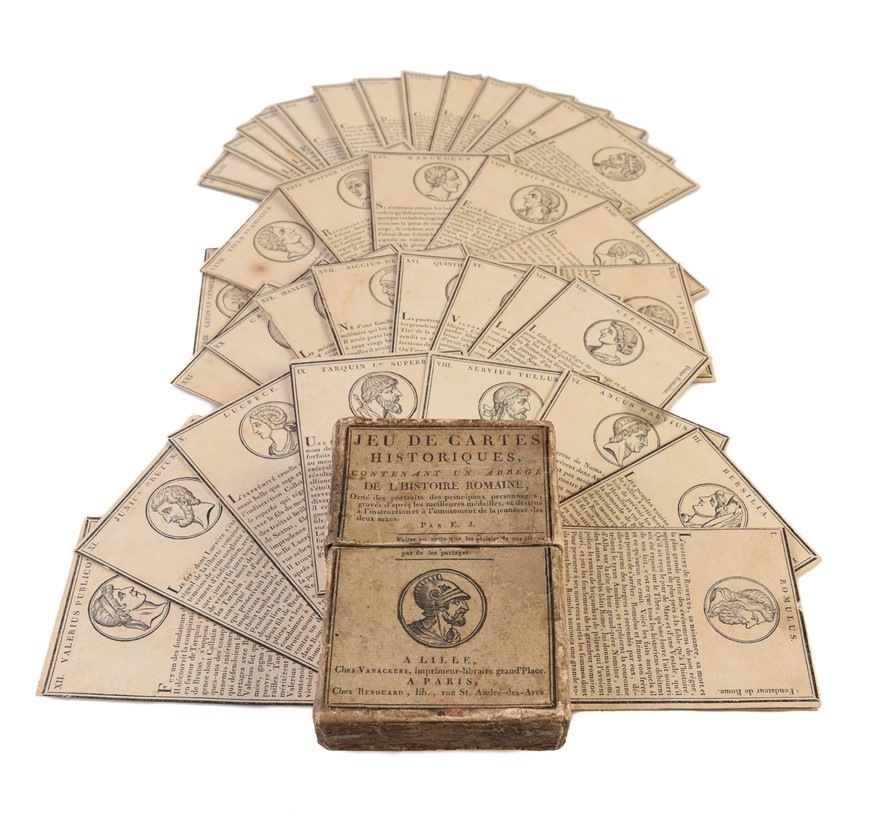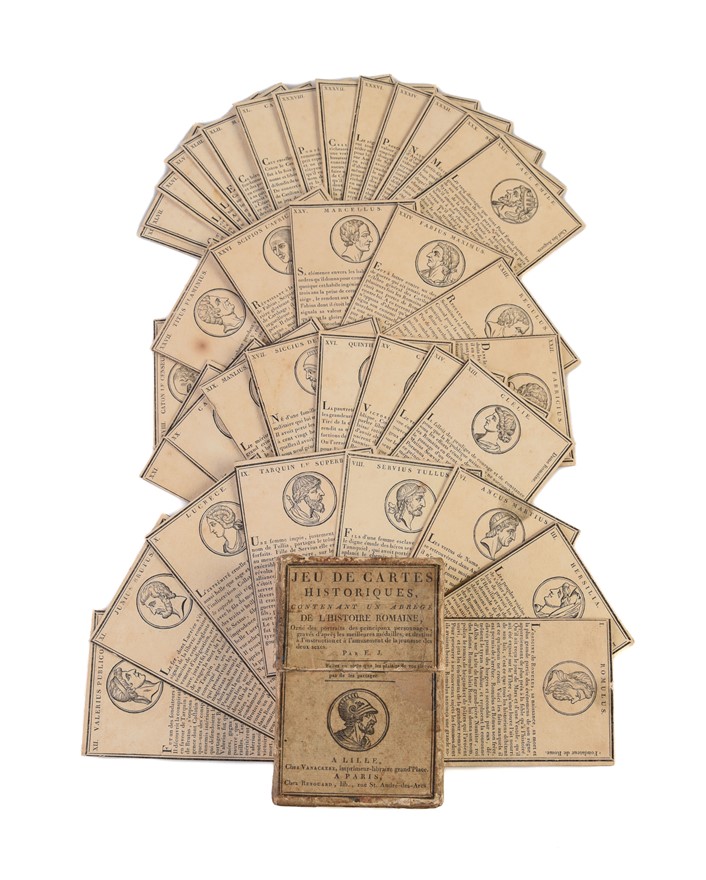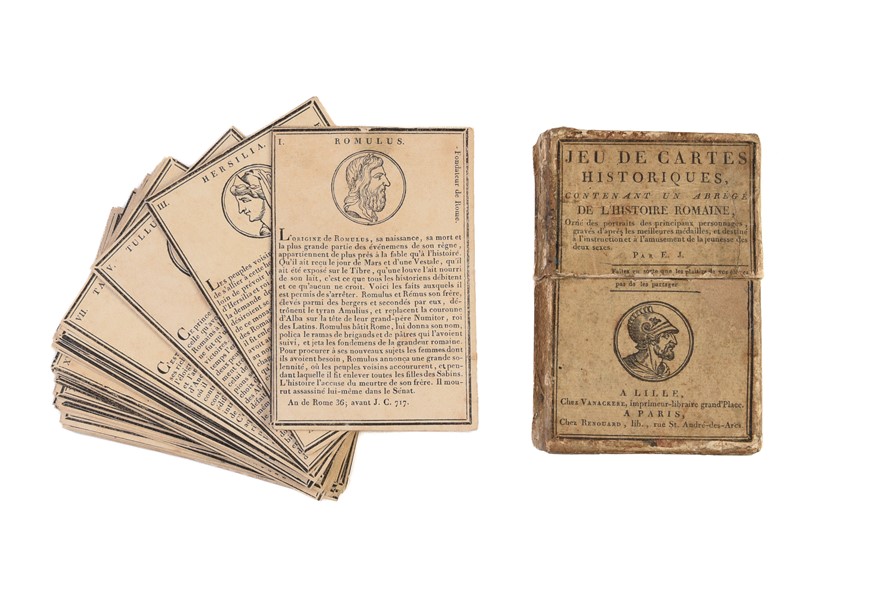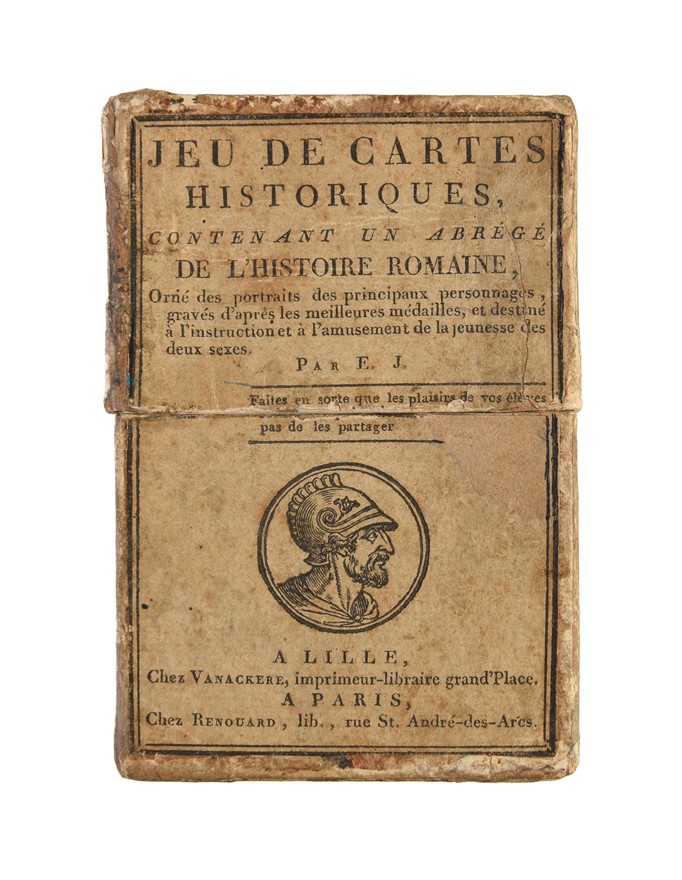Jeu de cartes historiques, contenant un abrégé de l'histoire romaine.
JOUY Etienne (c.1800)
£850.00
Available to view at our Curzon Street shop.
EDUCATIONAL PLAYING CARDS
Front of card case and each card with woodcut, numismatic portrait of Roman figure at head by Pierre-François Godard.
Woodcut and letterpress on card. 48 numbered cards (c.100 x 70mm, unevenly cut) in original, marbled paper-covered pasteboard slipcase (110 x 75mm), title pasted on to full length of case with roundel of Tullus Hostilius (wear to extremities, marbled paper worn at corners, unobtrusive loss to portion of title label, with loss of a couple of words of text).
À Lille, chez Vanackere; À Paris, chez Renouard,
A handsome suite of 48 letterpress-printed game cards in original marbled paper slipcase, constituting, as the title indicates 'a historical card game' for the instruction and amusement of boys and girls. A history of the Roman Empire told through its Emperors - and very occasionally, their wives and mothers - these cards begin with Romulus on card I, and end with Octavian Augustus, card XLVIII. Along with a profile portrait of each Roman figure, copied from coinage, is a biography, dates, and in the top right of the card, a brief account of the individual's claim to fame (Romulus - 'Fondateur de Rome', Camillus, 'dictateur', Aurelia, 'Mere de Cesar', Portia, 'femme de Brutus' and so on). Aside from some thumbing to the head of Romulus' card where the deck would have been pulled from the slipcase, these cards are in excellent condition; perhaps this educational game was not as amusing or appealing to its young audience as its creators hoped, and was little played with.
Described as being 'par E.J.', named elsewhere as 'V.E.' or 'E' Jouy, these cards were produced by Victor-Etienne de Jouy and engraver Pierre-François Godard, and sold by several stationers, booksellers and publishers in Lille and Paris in the early nineteenth century, including Ernest Vanackere, Gabriel-Henri Nicolle and, as here, Antoine-Auguste Renouard. Though Hargrave in A History of Playing Cards identifies their first being sold by Vanackere in the 1760s, the BnF dates the earliest packs to the first decade of the nineteenth century.
As is to be expected with an ephemeral, popular form such as these, sold by stationers and booksellers in various places, the publishing history of this deck is unclear. It certainly ran to more than one printing, as we have found three other variant copies of this deck: one at the British Museum (Schreiber no.168) sold by Vanackere and Nicolle, rather than Vanackere and Renouard as here, with an additional card of Regle de Jeu; one in a private collection, naming Vanackere and Nicolle, also with a Regle card but with 47, rather than 48 numbered cards; and one at the BnF, described as being without the Regles card, like the present pack, but numbered as the first of a set of more than ten educational decks of 'jeu de cartes' on different subjects. Formatted almost identically to the present set, extant copies of these other sets are numbered, and are on a variety of subjects that include the French monarchy, English history, ancient Greek history, geography, the New Testament, music, and mythology, among others.
First card thumbed and a little chipped at head, otherwise in excellent condition.
C. P. Hargrave, A History of Playing Cards and a Bibliography of Cards and Gaming (2000), pp.65-66. Schreiber, Catalogue of the collection of playing cards bequeathed to the Trustees of the British Museum by the late Lady Charlotte Schreiber (British Museum, Longman, 1901), no.168 (variant copy).
Stock Code: 251691







